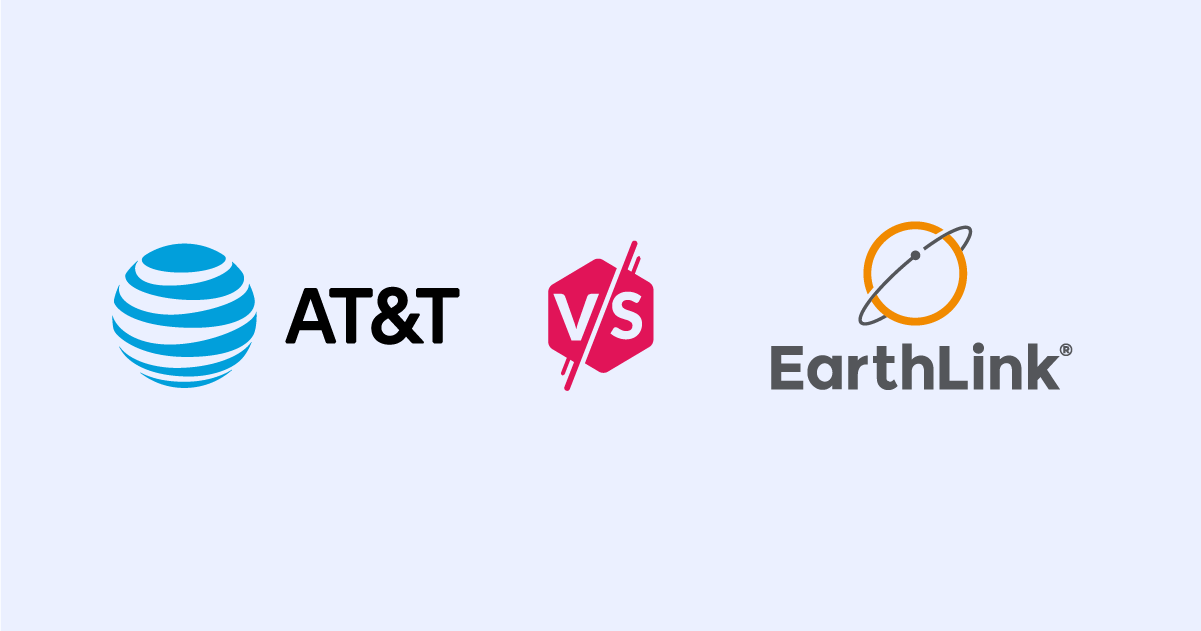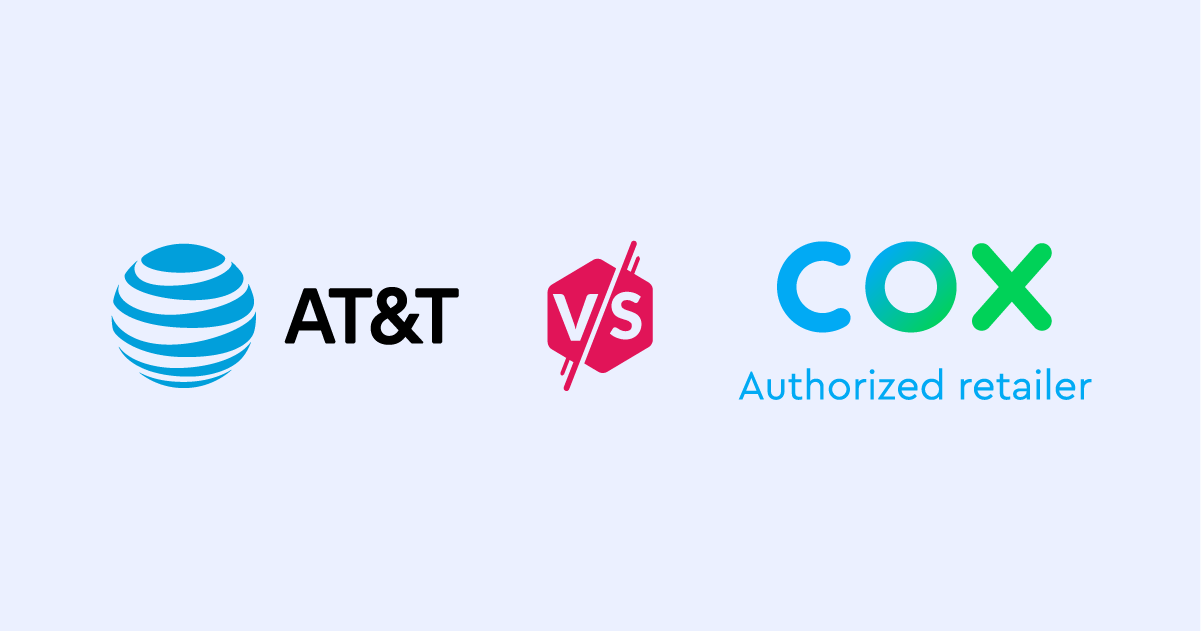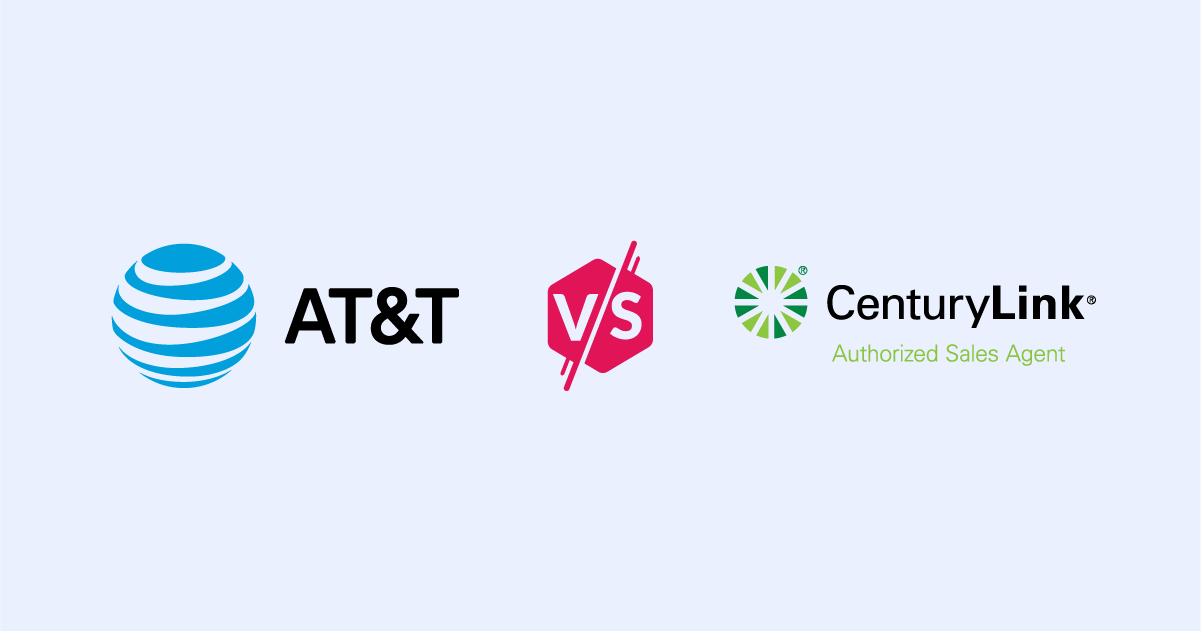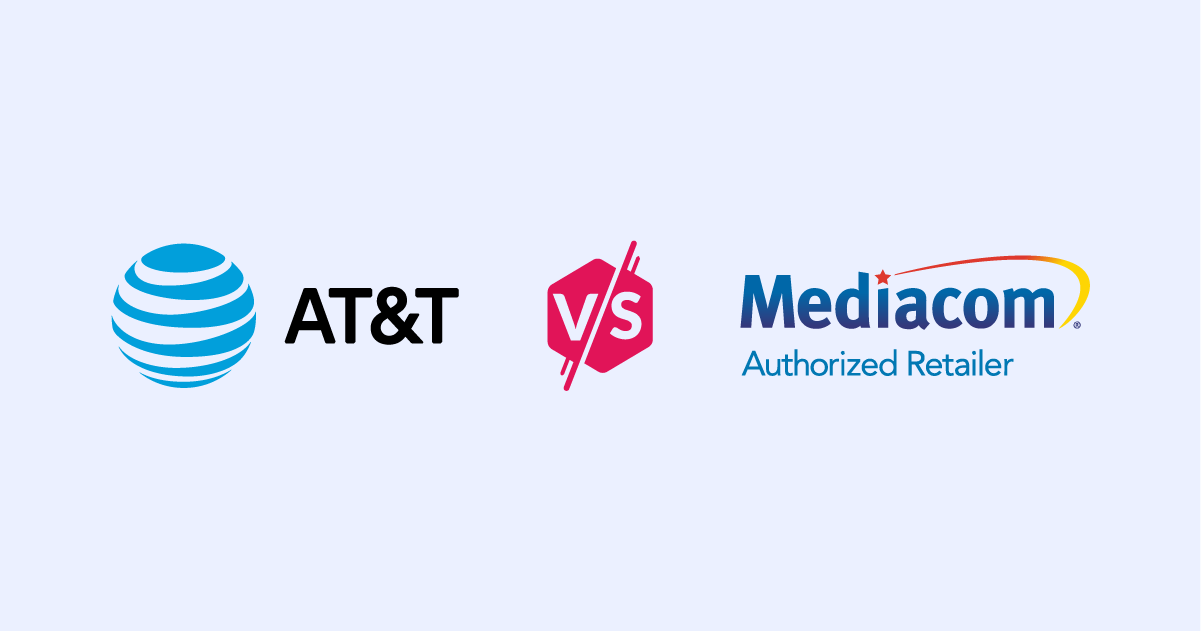AT&T vs. Frontier: Which Internet Provider Is Best for You?
Both providers offer fiber and DSL internet, but AT&T may have the upper hand in your area with pricing and variety.
Jun 16, 2023 | Share
Provider Comparisons (Versus)
-
Best for price
- Great fiber internet prices
- Excellent reliability and customer service
- Data caps on some plans
-
Best for simplicity
- Unlimited data
- Wide DSL availability
- Data caps on some plans
Data as of 02/01/23. Offers and availability may vary by location and are subject to change.
Compare AT&T and Frontier head to head
AT&T is the best choice for fiber internet. It has four fiber plans at great prices, making it one of the best internet services for gaming. Frontier is no slouch in delivering fast fiber speeds, but its fiber network is far less available than AT&T’s. Both primarily deliver DSL internet if fiber isn’t in your area, although Frontier has the upper hand in megabit-per-dollar value.
- Customer rating: 3.7/5
- Price: $55.00–$180.00/mo.
- Speed: 25–5,000 Mbps
- Internet type: DSL, fiber, fixed wireless
- Data cap: None–1 TB
- Contract: Monthly
- Customer rating: 3.5/5
- Price: $49.99–$154.99/mo.
- Fiber speed: 500–5,000 Mbps
- Internet type: DSL, fiber
- Data cap: None
- Contract: Optional 1-year contract with Visa Reward Card
Want to know if AT&T or Frontier are in your area? Take a look by typing in your zip code below.
Plans and pricing: AT&T vs. Frontier
Overall, AT&T has a larger footprint across the US than Frontier. Both primarily offer DSL internet as they slowly expand their fiber networks. But, if you want a variety of options—including fixed wireless—then AT&T is the way to go.
AT&T plans and pricing
| Package | Price | Speed | Type | Details |
|---|---|---|---|---|
| AT&T Internet 100 | $55.00/mo.* | 100 Mbps | Fiber | |
| AT&T Internet 300 | $55.00/mo.* | 300 Mbps | Fiber | |
| AT&T Internet 500 | $65.00/mo.* | 500 Mbps | Fiber | |
| AT&T Internet 1000 | $80.00/mo.* | 1,000 Mbps† | Fiber | |
| AT&T Internet 2000 | $110.00/mo.* | 2,000 Mbps† | Fiber | |
| AT&T Internet 5000 | $180.00/mo.* | 5,000 Mbps† | Fiber | |
| AT&T Internet up to 75 Mbps | $55.00/mo.# | 75 Mbps | DSL | |
| AT&T Internet up to 100 Mbps | $55.00/mo.* | 100 Mbps | DSL | |
| AT&T Fixed Wireless | $59.99/mo.** | 10–25 Mbps | Fixed Wireless | |
| AT&T Internet Air | $55.00/mo. | 40–140Mbps | Fixed Wireless/5G |
*Plus taxes. Price after $5/mo Autopay & Paperless bill discount (w/in 2 bills). Monthly State Cost Recovery Charge in TX, OH, NV applies.
† Internet speed claims represent maximum network service capability speeds and based on wired connection to gateway. 1GIG speeds avail. to new customers with the latest router (“BGW320”) and recommended setup. For 5 GIG speed, single device wired speed maximum 4.7 Gbps. Actual customer speeds may vary based on a number of factors and are not guaranteed. For more information, go to www.att.com/speed101.
# for 12 mos, plus taxes & equip. fee. $10/mo equip. fee applies. Incl 1TB data/mo. overage chrgs apply
** for 12 months plus taxes. Includes a $5/mo. discount with AutoPay and paperless billing discount. $10/mo. equipment fee applies.
AT&T is primarily a DSL internet provider—for now, at least. AT&T plans to reach 30 million locations with its fiber network by 2025.7
AT&T’s two DSL plans are pretty cheap in terms of megabits per dollar when you compare them against Frontier. If fiber isn’t in your area, then AT&T’s DSL is the way to go unless you have access to cable internet.
AT&T’s fiber plans are reasonably priced too. It also offers incredibly fast speeds over fiber—5G Internet delivers the fastest speeds from a major provider in the United States. You likely won’t need 5,000 Mbps speeds (unless you’re mining cryptocurrency). The Internet 300 plan will be a much better deal, although the price is still higher than what you can get from Frontier.
Frontier plans and pricing
| Package | Price | Speed | Type | Details |
|---|---|---|---|---|
| Frontier Internet (DSL) | $49.99/mo.§ w/Auto Pay & Paperless Bill | Call provider for details| | DSL | View Plans |
| Frontier Fiber 500 | $49.99/mo.† w/Auto Pay & Paperless Bill | 500 Mbps | Fiber | View Plans |
| Frontier Fiber 1 Gig | $69.99/mo. ‡ w/Auto Pay & Paperless Bill | 1000 Mbps | Fiber | View Plans |
| Frontier Fiber 2 Gig | $99.99/mo. ** w/Auto Pay & Paperless Bill | 2,000 Mbps | Fiber | View Plans |
| Frontier Fiber 5 Gig | $154.99/mo. # w/Auto Pay & Paperless Bill | 5,000 Mbps | Fiber | View Plans |
* w/ Auto Pay & Paperless Bill per month for 24 mos. One-time charge on disconnect applies. Call for details. In select areas where available.
✝ w/ Auto Pay & Paperless Bill. Max wired speed 500/500 Mbps. Wi-Fi, actual & average speeds vary. One-time charges apply. In select areas where available.
‡ w/ Auto Pay & Paperless Bill. Max wired speed 1000/1000 Mbps. Location dependent. Wi-Fi, actual & average speeds vary. One-time charges apply. In select areas where available.
**w/ Auto Pay & Paperless Bill. Max wired speed 2000/2000 Mbps. Wi-Fi, actual & average speeds vary. One-time charges apply. In select areas where available.
#w/ Auto Pay & Paperless Bill. Max wired speed 5000/5000. Wi-Fi, actual & average speeds vary. One-time charges apply. In select areas where available.
Like AT&T, Frontier is mostly a DSL internet provider with some fiber. Both are working to swap out old DSL lines with the faster fiber connections, but if DSL is all you can get, then AT&T is the way to go.
Frontier goes head-to-head with AT&T at speeds of 500 Mbps and higher, but Frontier has the upper-hand when it comes to price. Frontier’s 500 Mbps plan is $15 cheaper than AT&T. Frontier’s gig and multi-gig plans are also less expensive than similar plans offered by At&T
Overall, Frontier aims to reach 10 million locations with its fiber service by 2025. The company recently launched a 5 Gbps fiber plan and expects to reach 10 Gbps in the near future.8

Deal and promotions: AT&T vs. Frontier
| Order a fiber internet plan to get a reward card worth $100 or $150. You get the $100 card with the 300 Mbps and 500 plans and the $150 card with the gigabit plan or faster. |
| Get $10/mo. off YouTube TV for one year on all fiber plans. Terms and Conditions apply. Get the Deal |
Extra fees: AT&T vs. Frontier
Data as of 02/14/23. Offers and availability may vary by location and are subject to change.
Frontier’s monthly rates include autopay and paperless billing discounts, so expect to pay $7.99 extra each month if you opt out of both. If anything, Frontier’s Internet Infrastructure Surcharge fee should be a little alarming, as you’re investing in maintenance and other network infrastructure costs.1
Want to know if AT&T or Frontier are in your area? Take a look by typing in your zip code below.
Customer ratings: AT&T vs. Frontier
| Overall Rating | Speed Rating | Price | Reliability | Customer Service | |
|---|---|---|---|---|---|
| AT&T | 3.7 | 3.8 | 3.5 | 3.7 | 3.7 |
| Frontier | 3.5 | 3.7 | 3.2 | 3.6 | 3.5 |
* Rating based on a five (5) point system used in our customer satisfaction survey. Higher is better.
AT&T takes the fourth spot for overall satisfaction among the 13 national internet providers in our latest customer satisfaction survey. Its strongest point is price satisfaction, which isn’t surprising given the speeds you get for the money. In fact, it has a better pricing score than the national average. AT&T also ranks in the top five for customer service, reliability, and speed satisfaction, showing that it’s a really solid provider if you want fiber internet.
Frontier also delivers fiber internet, but its satisfaction ratings are far lower than AT&T. It ranks in the bottom half across the board, with its strongest point being price satisfaction. Frontier doesn’t increase prices for at least four years, making it a better choice over other providers with shorter promotional periods. Around 65% of those surveyed reported no price hikes, which is better than the national average.
Best TV and internet bundles
| Internet speed | TV channels | Price | Details | |
|---|---|---|---|---|
| DIRECTV ENTERTAINMENT + AT&T Fiber Internet 300 | Up to 300 Mbps | 75+ | $119.99/mo.* | |
| DIRECTV CHOICE™ + AT&T Fiber Internet 1,000 | Up to 1,000 Mbps | 105+ | $164.99/mo.* | |
| Frontier 500 + YouTube TV | Up to 500 Mbps | 100+ | $112.98/mo.# | View Plans |
| Frontier 1 Gig + YouTube TV | Up to 1,000 Mbps | 100+ | $132.98/mo.# | View Plans |
* for 24 months plus taxes & internet equip. fee w/ 24-mo. TV agmt. Autopay & paperless bill req’d. After 2 years, then month to month at then current prevailing prices unless cancelled. $10/mo. internet equip. fee applies. Geo & svc. restr’s apply.
# Limited time offer for Frontier Internet subscribers who are first-time YouTube TV customers. Terms apply.
AT&T bundles with DIRECTV, however you have to order the two separately, just like you would with any other service, and there are no perks or discounts like what usually come with bundle packages.
Frontier bundles YouTube TV with its fiber and DSL services. Customers save $10 a month by bundling and get 100+ channels of live TV.
Internet types: AT&T vs. Frontier
| Internet type | Details | |
|---|---|---|
| DSL Fiber Fixed wireless | ||
|
| DSL Fiber | View Plans |
Both companies primarily offer DSL, which uses telephone cables to bring the internet into your home. A 140 Mbps or slower speed is typical for a DSL connection, although Windstream’s DSL service can reach up to just over 200 Mbps.
Fiber-to-the-home services from AT&T and Frontier have a somewhat smaller footprint, generally covering around 30% of their national markets. AT&T is the only provider of the two with a fixed wireless service, however, which sends internet via transmitters to homes that can’t get a landline connection.
Should you get fixed wireless?
Fixed wireless isn’t just for rural areas. Perhaps you live in an area where fiber and DSL internet just isn’t reliable. Take a look at our fixed wireless internet guide for more about speed, plans, and pricing.
Data caps: AT&T vs. Frontier
| Data Cap | Details | |
|---|---|---|
|
| View Plans |
Frontier doesn’t enforce data caps on its DSL and fiber services, and AT&T refrains from imposing a data cap on its fiber connection. But AT&T limits data on its DSL and fixed wireless services to keep the services affordable. The company also admits that it can’t always measure your data use on a DSL connection, so it’s possible that you can go over the 1 TB limit, and it doesn’t show up in the data tracker. If that happens, you won’t be charged.2
Contracts: AT&T vs. Frontier
| Contract length | Details | |
|---|---|---|
|
| View Plans |
AT&T doesn’t require a contract in most cases. Instead, you pay a discounted price each month for 12 months, and then the plans increase around $10 (DSL) and $20 (fiber)—the fixed wireless service doesn’t appear to have promotional pricing.
However, AT&T may require a contract if you order internet service with additional promotional discounts. The early termination fee applies if you cancel service after 14 days.3 The fee is prorated and reduced each month.4
Frontier also doesn’t enforce contracts for internet service. However, you must sign a one-year agreement if you accept a Visa Reward Card when you sign up for the Fiber 500 or Fiber 1 Gig plan. A two-year contract only comes into play when you get satellite TV.
Installation: AT&T vs. Frontier
| Installation options | Details | |
|---|---|---|
|
| View Plans |
* When you order service online.
Modern AT&T fiber installations include a termination box outside and a fiber jack installed in the room where AT&T’s desktop optical network terminal (ONT) resides—this device is actually a gateway supporting fiber. Older fiber installations have a smaller ONT mounted on the fiber jack and use Ethernet to connect a standard gateway or router.
With Frontier’s fiber-to-the-home service, a technician installs the ONT in your garage, basement, or closet. After that, the ONT connects to your home’s existing Ethernet or coaxial cable wiring—a MoCA adapter and splitter are required for coaxial cabling and TV. The supplied gateway connects to the Ethernet or coaxial cable jack mounted in the wall.
Like self-installing cable and DSL equipment, your home already needs a fiber connection before you can order a self-install kit from AT&T. Frontier currently does not have a self-install option.
Availability: AT&T vs. Frontier
AT&T has a larger footprint stamped across the US than Frontier. Most of its coverage spans through the south and southeast and stretches up into Wisconsin and Michigan. There are scattered spots throughout Kansas and Oklahoma and very little elsewhere until California.
According to the Federal Communications Commission, AT&T’s DSL internet covers 96% of its nationwide market while fiber is available in 31% of its service areas—fixed wireless is available in just 4%.9
Frontier’s primary target is in rural areas. Its DSL service is available in 25 states, mainly in the Northeast, Southeast, and Southwest. Its Frontier Fiber Internet is limited to portions of California, Florida, Indiana, and Texas. Frontier expects to expand its fiber-to-the-premises service in California by 350,000 locations over the next six years.10
To see which AT&T and Frontier plans are available in your area, enter your zip code below:
Final call: AT&T vs. Frontier
AT&T is our top pick of the two for fiber internet. The incredibly fast speeds are great, and there’s a wider variety of plans that should fit the needs of most homes. But, like Frontier’s fiber service, it’s hard to find unless you live around densely populated areas like Atlanta, Dallas, Houston, Chicago, Orlando, and San Francisco.5
AT&T is also our top pick for DSL internet. But if you don’t have access to either DSL or fiber, AT&T has your back with its fixed wireless service.
Methodology
Our HighSpeedInternet.com editorial team bases our analyses on customer input from our annual customer satisfaction survey, results from our speed test tool, and proprietary internet provider data on speeds and pricing. To strengthen our research, we look closely at provider contracts to get hard-to-find information on price hikes, data caps, and extra fees, and we keep tabs on the latest news reports and online reviews. When applicable, we also rely on our personal experiences testing these services.
More about AT&T and Frontier
Sources
- Frontier Communications, “Answering Your Questions,” Accessed January 4, 2022.
- AT&T, “Get Home Internet Data Usage Info,” Accessed January 4, 2022.
- AT&T, “Contract Requirements for U-verse, AT&T Internet, AT&T Phone Service,” December 6, 2018. Accessed January 3, 2022.
- AT&T, “AT&T Internet Cancellation Policy,” Accessed January 4, 2022.
- AT&T, “Want to Know If You Can Get AT&T Fiber at Your Address?” Accessed January 4, 2022.
- AT&T, “Get Home Internet Data Usage Info,” Accessed January 4, 2022.
- AT&T, “AT&T and Frontier Communications Strike Network Deal,” October 6, 2021. Accessed January 4, 2022.
- Frontier, “Frontier Investor Day Presentation,” August 5, 2021. Accessed January 4, 2022.
- Federal Communications Commission, “Fixed Broadband Deployment,” December 31, 2020. Accessed January 4, 2022.
- Frontier Communications, “Before the Public Utilities Commission of the State of California,” December 24, 2020. Accessed May 4, 2021.
Author - Kevin Parrish
Kevin Parrish has more than a decade of experience working as a writer, editor, and product tester. He began writing about computer hardware and soon branched out to other devices and services such as networking equipment, phones and tablets, game consoles, and other internet-connected devices. His work has appeared in Tom’s Hardware, Tom's Guide, Maximum PC, Digital Trends, Android Authority, How-To Geek, Lifewire, and others. At HighSpeedInternet.com, he focuses on network equipment testing and review.
Editor - Rebecca Lee Armstrong
Rebecca Lee Armstrong has more than six years of experience writing about tech and the internet, with a specialty in hands-on testing. She started writing tech product and service reviews while finishing her BFA in creative writing at the University of Evansville and has found her niche writing about home networking, routers, and internet access at HighSpeedInternet.com. Her work has also been featured on Top Ten Reviews, MacSources, Windows Central, Android Central, Best Company, TechnoFAQ, and iMore.




